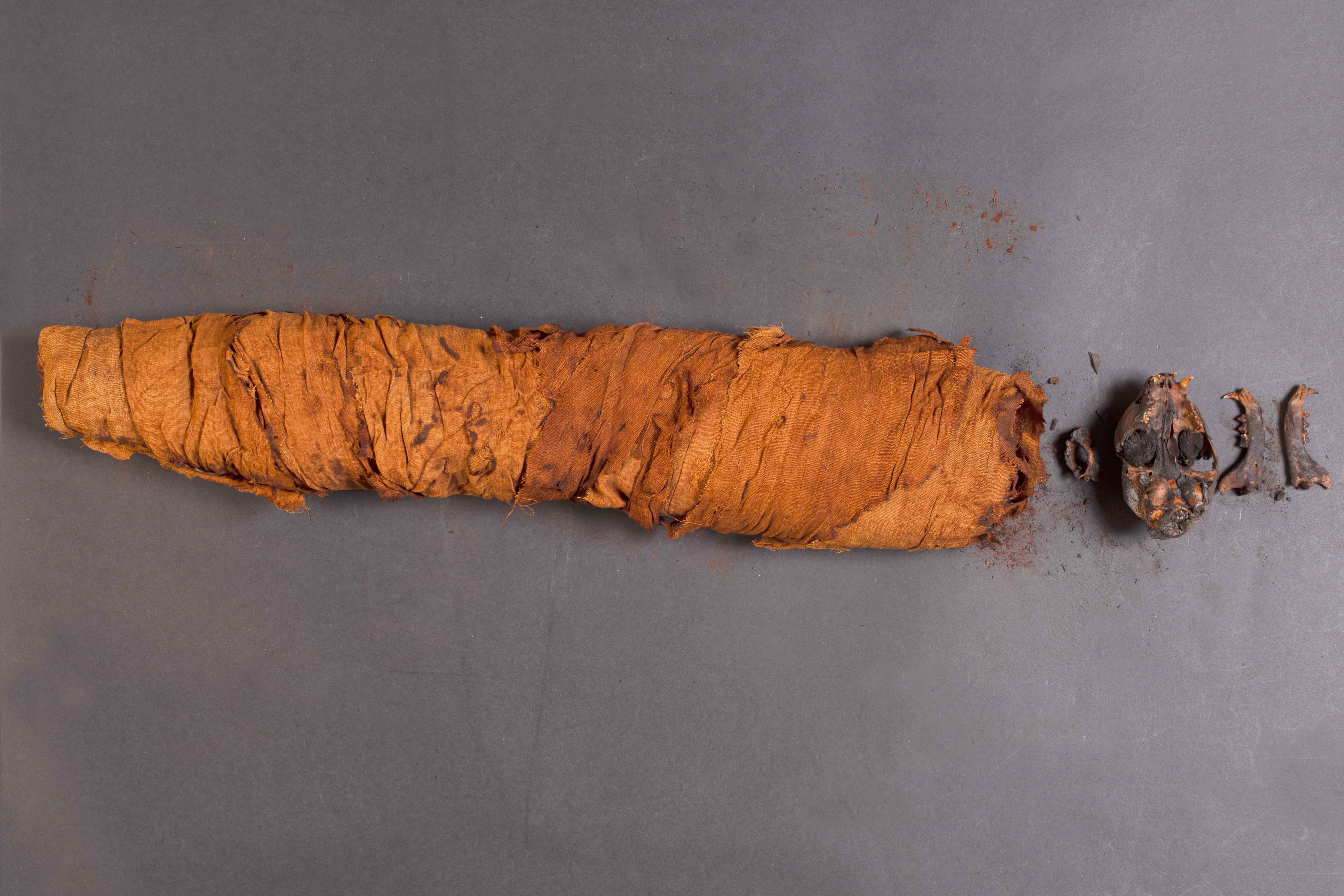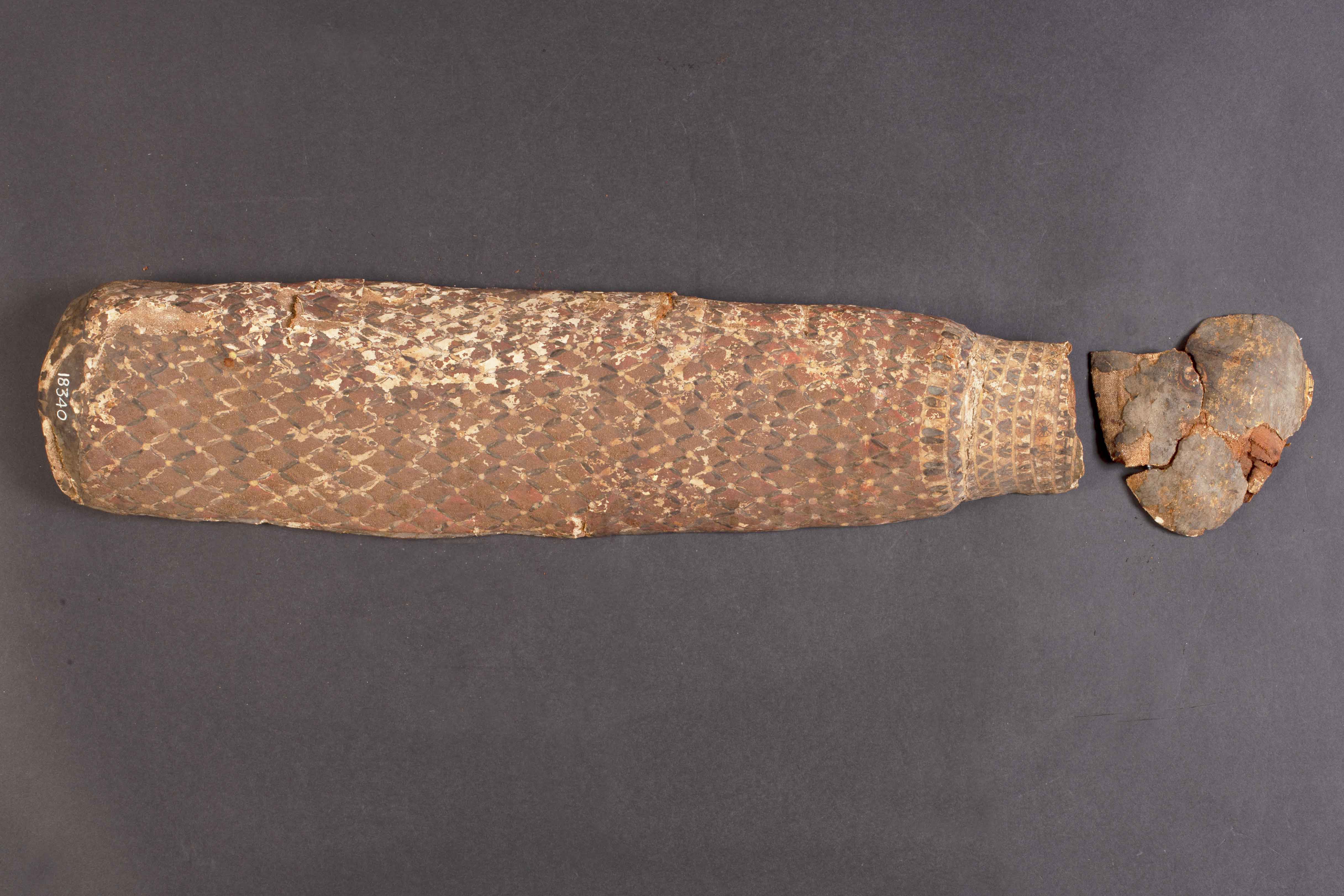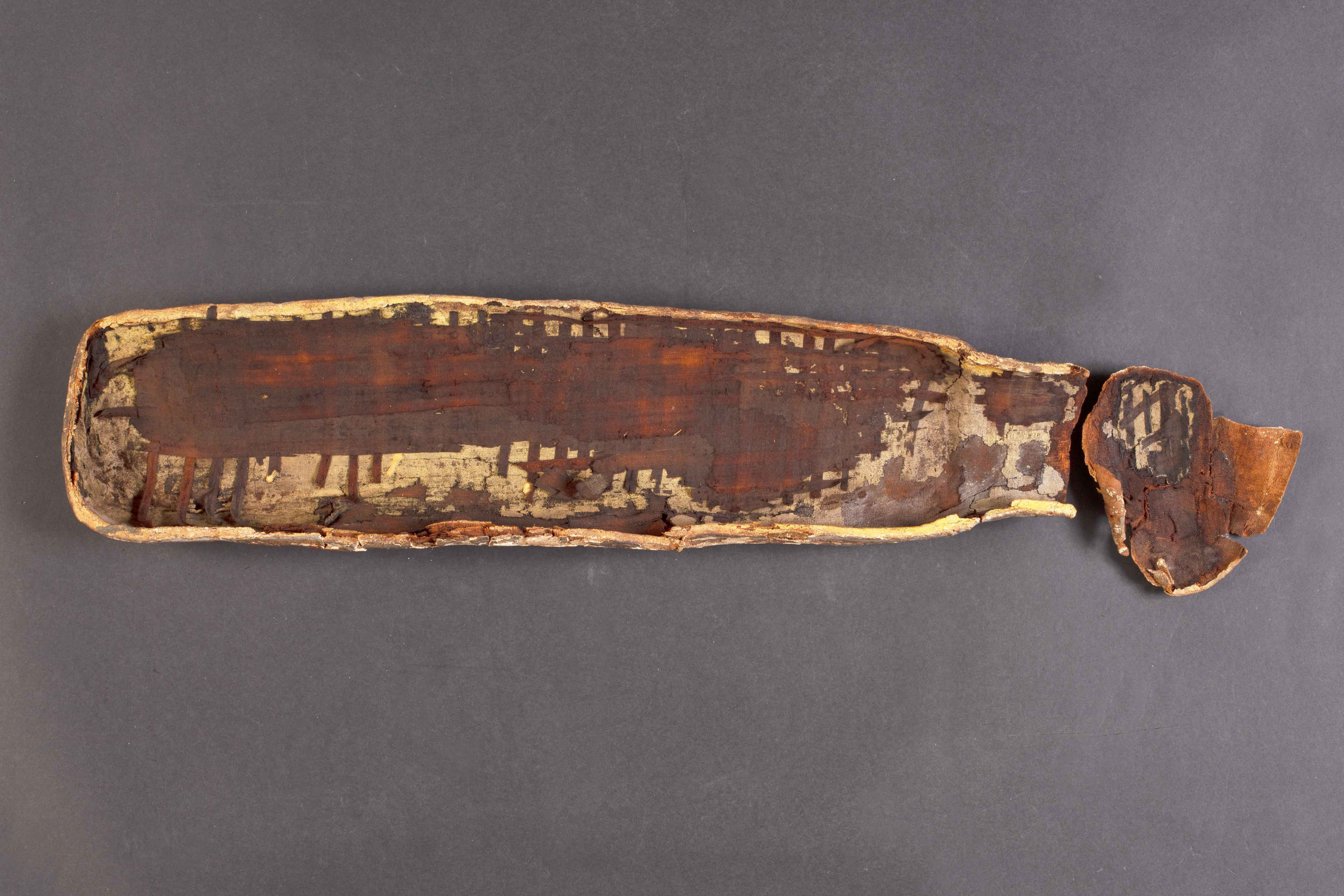Cat Mummy
Artist: Unknown
Date: Third Intermediate Period and the Late Age (750-390 BC)
Classification: Mummy
Dimensions: 68 cm long
Materials: Organic, Cardboard
Adopted By: The California Chapter
Total Cost: € 15,000
Description
This cat mummy, coserved in a painted cardboard case, is datable between the Third Intermediate Period and the Late Age (750-390 BC). The context of discovery is unknown, and more detailed information such as secure dating is needed. However, refined workmanship displays a rare example of cat mummy.
Most of these cat mummies belong to the category of votive offerings. Pilgrims and devotees were used to bringing offers to the temples of the divinity, that could then manifest in the cat. The goddess most connected to this feline is the goddess Bastet, particularly revered in the late age. Located in Saqqara and Bubastis, a city in the Delta where there was a large temple of the goddess Bastet, the largest cat necropolises is a destination for pilgrimages.
The mummy, enclosed inside a sarcophagus made of bivalve cartonnage, was broken at the neck. It contains a skull (with tissue fragments inside the orbital cavities), and the wrapped body is in linen cloth bandages of different colors and technical reduction. The sarcophagus figure and the removal of the mummy allowed for the inspection of the inside surface. The decorative model enveloped the exterior and went around the mummy.
Bandages
The body was tightly wrapped with an S-twist, by a bandage (fabric A1), varying in width from 2.5 to 3.5 cm. It is possible that the overall thickness of this bandage was once greater and that the fabric degraded. On this bandage, which had to hold the skeleton in position, there were two shrouds placed, now only visible from the traces present on the valves of the sarcophagus. The first shroud, with a slightly sparser texture, was more in contact with the body (Fabric B3), and a second one (Fabric C4) externally covered the whole mummy.
Due to the advanced degradation of the material and its contact with organic residues from the animal and stuffing, it is difficult to determine if these shrouds were intentionally dyed originally or if the brown color is simply the product of cellulose oxidation. The second shroud (fabric C), with a denser weave, presents a dark brown color, uniform, and compact, which would suggest original dyeing and the presence of an etching of the fibers to favor the brown color. The hypothesis supports that both fabrics of the shrouds were for the bandages. Even if it is not possible to trace a definite pattern, it would justify if one of the two fabrics had dyed and the other did not. Their interweaving would have produced a polychrome geometric decorative module.
This procedure was usual in animal mummies of the period. There is a decorative module with a series of vertical bandages on shroud C. They intersect with horizontal bandaging. Their width (with both margins folded inside to have finished margins) is 0.4 cm. From the traces visible on the inner valves of the sarcophagus, all the vertical bandages are below the horizontal ones. The securing of the horizontal ones is not known because the lateral sections are absent. Since the horizontal bandaging was perfectly parallel, led us to conclude that they used a single bandage that "turned" around the mummy because there are no traces of twisting or slipping of the cloths.
One hypothesis might be that the bandages were secured individually by resin points (which was usually the way the bandages of the decorative modules were attached) along one side. At the moment, there is no way to confirm this hypothesis. The scarce comparisons with mummies of the period and preserved similar to ours do not provide restorers with sufficient information on the actual modalities of bandaging the mummy object. There was a series of fabric fragments in linen and resin on the original bandage. It is impossible to establish if they come from this mummy or other artifacts. It seems unlikely that they could have carried out the decorative module described above on a coarse and poorly finished bandage.
Restorers and specialists analyzed the bandage and identified tissues. The differences in reduction between one fragment and another are minimal. They would suggest that they all come from the same fabric. However, fabric 2 has a denser texture and a more pronounced coloration, perhaps due to the previous dyeing.
State of Preservation
The mummy presented an advanced state of overall degradation, caused by possibly inaccurate stuffing and a previous restoration intervention that probably took place before it entered the museum collections. The head of the animal was not on the rest of the body and did not include bandages, except for the remnants of resin dressings present inside the orbital cavities and part of the skull itself. The skull, without external banding, was powdery and very fragile. The first step of the invasive restoration was the insertion of two wooden posts between the original bandages and those of restoration. The bad stuffing and the loss of part of the bandage affect the solidity of the skeletal structure. However, the two posts along the sides worsened the mechanical problem. There were tears on the bandages.
Restoration Procedures
Restorers disassembled the mummy from the sarcophagus. Restorers removed some metal pins positioned in the lower section. They left most of these pins and the wooden posts since their removal would compromise the stability and integrity of the artifact. They steamed with a cold ultrasonic vaporizer to reduce deformation and dry creases in the bandages. Bandages were held in place by entomological pins and weights. Researchers and restorers decided not to reposition the skull inside the sarcophagus but preserve it on a suitable support. The skull, two mandibles, and a bone fragment are on a Plastazote ©10 support, controlled by strips of the same material held in place by stainless steel pins.
Detail
Adopted By:
The California ChapterInventory N°: 18340
Artist: Unknown
Date: Third Intermediate Period and the Late Age (750-390 BC)
Provenience: Egypt
Dimensions: 68 cm long
Materials: Organic, Cardboard
Department:
Egyptian and Near Eastern AntiquitiesCurators:
Dr. Alessia AmentaLaboratories:
Ethnological MaterialsTotal Cost
€ 15,000

Cat Mummy

Details
Adopted by: The California Chapter
Inventory: 18340
Artist: Unknown
Date: Third Intermediate Period and the Late Age (750-390 BC)
Provenience: Egypt
Classification: Mummy
Materials: Organic, Cardboard
Dimensions: 68 cm long
Department: Egyptian and Near Eastern Antiquities
Laboratory: Ethnological Materials
Description
This cat mummy, coserved in a painted cardboard case, is datable between the Third Intermediate Period and the Late Age (750-390 BC). The context of discovery is unknown, and more detailed information such as secure dating is needed. However, refined workmanship displays a rare example of cat mummy.
Most of these cat mummies belong to the category of votive offerings. Pilgrims and devotees were used to bringing offers to the temples of the divinity, that could then manifest in the cat. The goddess most connected to this feline is the goddess Bastet, particularly revered in the late age. Located in Saqqara and Bubastis, a city in the Delta where there was a large temple of the goddess Bastet, the largest cat necropolises is a destination for pilgrimages.
The mummy, enclosed inside a sarcophagus made of bivalve cartonnage, was broken at the neck. It contains a skull (with tissue fragments inside the orbital cavities), and the wrapped body is in linen cloth bandages of different colors and technical reduction. The sarcophagus figure and the removal of the mummy allowed for the inspection of the inside surface. The decorative model enveloped the exterior and went around the mummy.
Bandages
The body was tightly wrapped with an S-twist, by a bandage (fabric A1), varying in width from 2.5 to 3.5 cm. It is possible that the overall thickness of this bandage was once greater and that the fabric degraded. On this bandage, which had to hold the skeleton in position, there were two shrouds placed, now only visible from the traces present on the valves of the sarcophagus. The first shroud, with a slightly sparser texture, was more in contact with the body (Fabric B3), and a second one (Fabric C4) externally covered the whole mummy.
Due to the advanced degradation of the material and its contact with organic residues from the animal and stuffing, it is difficult to determine if these shrouds were intentionally dyed originally or if the brown color is simply the product of cellulose oxidation. The second shroud (fabric C), with a denser weave, presents a dark brown color, uniform, and compact, which would suggest original dyeing and the presence of an etching of the fibers to favor the brown color. The hypothesis supports that both fabrics of the shrouds were for the bandages. Even if it is not possible to trace a definite pattern, it would justify if one of the two fabrics had dyed and the other did not. Their interweaving would have produced a polychrome geometric decorative module.
This procedure was usual in animal mummies of the period. There is a decorative module with a series of vertical bandages on shroud C. They intersect with horizontal bandaging. Their width (with both margins folded inside to have finished margins) is 0.4 cm. From the traces visible on the inner valves of the sarcophagus, all the vertical bandages are below the horizontal ones. The securing of the horizontal ones is not known because the lateral sections are absent. Since the horizontal bandaging was perfectly parallel, led us to conclude that they used a single bandage that "turned" around the mummy because there are no traces of twisting or slipping of the cloths.
One hypothesis might be that the bandages were secured individually by resin points (which was usually the way the bandages of the decorative modules were attached) along one side. At the moment, there is no way to confirm this hypothesis. The scarce comparisons with mummies of the period and preserved similar to ours do not provide restorers with sufficient information on the actual modalities of bandaging the mummy object. There was a series of fabric fragments in linen and resin on the original bandage. It is impossible to establish if they come from this mummy or other artifacts. It seems unlikely that they could have carried out the decorative module described above on a coarse and poorly finished bandage.
Restorers and specialists analyzed the bandage and identified tissues. The differences in reduction between one fragment and another are minimal. They would suggest that they all come from the same fabric. However, fabric 2 has a denser texture and a more pronounced coloration, perhaps due to the previous dyeing.
State of Preservation
The mummy presented an advanced state of overall degradation, caused by possibly inaccurate stuffing and a previous restoration intervention that probably took place before it entered the museum collections. The head of the animal was not on the rest of the body and did not include bandages, except for the remnants of resin dressings present inside the orbital cavities and part of the skull itself. The skull, without external banding, was powdery and very fragile. The first step of the invasive restoration was the insertion of two wooden posts between the original bandages and those of restoration. The bad stuffing and the loss of part of the bandage affect the solidity of the skeletal structure. However, the two posts along the sides worsened the mechanical problem. There were tears on the bandages.
Restoration Procedures
Restorers disassembled the mummy from the sarcophagus. Restorers removed some metal pins positioned in the lower section. They left most of these pins and the wooden posts since their removal would compromise the stability and integrity of the artifact. They steamed with a cold ultrasonic vaporizer to reduce deformation and dry creases in the bandages. Bandages were held in place by entomological pins and weights. Researchers and restorers decided not to reposition the skull inside the sarcophagus but preserve it on a suitable support. The skull, two mandibles, and a bone fragment are on a Plastazote ©10 support, controlled by strips of the same material held in place by stainless steel pins.
Media

Cat Mummy - Before Restoration

Cat mummy's painted cardboard case - Before Restoration

Cat mummy, inside view of the painted cardboard case - Before Restoration

© 2025 Patrons of the Arts
in the Vatican Museums
Vatican Museums V-00120,
Vatican City State (Europe)
+39 0669864499
